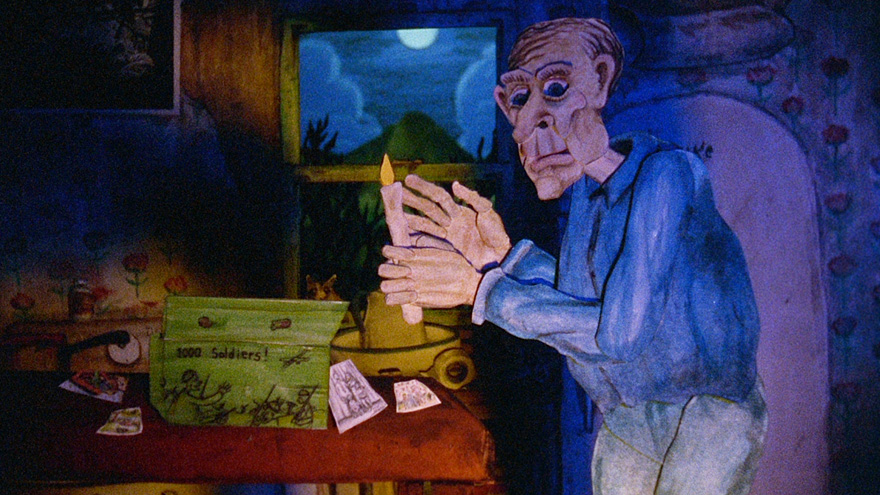Tribeca 2012 Review: Consuming Spirits

Consuming Spirits Still
I like to whine about how “Hollywood” the Tribeca Film Festival is, about how similar most of its Amer-indie slate feels.1 As many workshopped talkies as one may endure, this is still New York City, historically a hotbed of experimental cinema. There is no handbook for these adventurous filmmakers; no one telling them the gun must go off in the third act. It is this freedom that allows them to come up with some of the wildest films imaginable and execute them on a (sometimes literal) shoestring.
Chris Sullivan’s Consuming Spirits is listed as an experimental animation, but I think that’s a bit of an unfair description. While its technique of handmade 16mm animation certainly qualifies it as a trial in patience, it is, at its core, a narrative. The “experiment” is a mere playfulness with time, scale and reality; it may even be too tame to be considered all that experimental in some circles. I imagine it is listed as such because no one else in the fest wanted it, and that’s a shame.
As a narrative Sullivan’s film is an invigorating experience, unencumbered by the silly rules we’ve imposed on the storytelling process. It is a 130 minute portrait of a small Appalachian town whose inhabitants are as gruesome as they are endearing. Sullivan employs stop-motion, paper-craft puppetry and hand-drawn animation to tell his tale, each form placing the audience in a different temporal and/or emotional realm.
The film tells the story of a small Appalachian town called Magguson. When Gentian (or Genny) Violet, a Jane-of-all-trades who drives a schoolbus, works at the local newspaper and gives tours at the museum, hits a transient nun on the road one night, she set off a chain reaction that ultimately unravel’s one family’s well-hidden dirty laundry. Part thriller, part family drama and part dreamscape, Consuming Spirits is like no other film I can recall.2
Sullivan isn’t without a sense of humor; in fact he’s downright puckish. The title itself is a pun and the film is peppered a few good laughs few geared directly at the cinephile set. Like the scene in which one character picks out a skin flick featuring mental patients putting on a lascivious show: “Titty Cut Follies.” Fake porno titles are a comedic past-time at this point, but the humor here is brilliant. By invoking Frederick Wiseman’s groundbreaking documentary, Titicut Follies, Sullivan gets more than a cheap laugh; he ties in the horrors of a sanatorium without having to show it to you. (Magguson has a sanatorium that plays a central role to the film’s plot.)
The animation itself is astounding. Sullivan’s characters are monstrous and beautiful. Their faces are creased and pocked with bags under their eyes, their teeth yellowed or blackened or barely there. These paper stand-ins are imbued with all the frailties and deformities of humans. Perhaps it is their closeness to how people actually look, warts and all, that makes them so tough to look at. They are more mirror than they are lens unlike, say, the airbrushed hardbodies we see at the multiplex.
The hand-drawn segments are less invigorating, but nonetheless wild to look at. As the narrative unfurls, the form comes into sharper focus, making it a bit clearer why different techniques are employed. It’s a deft move and one I appreciate more now that I have digested the film a bit.
Chris Sullivan spent almost fifteen years making Consuming Spirits and it’s a marvel to behold. All movies are hard to make, so he doesn’t get bonus points for taking his time. However, by not relenting when the technology changed, by seeing his vision through after all these years, Sullivan brought to life a unique piece of work that I am glad wasn’t rushed.
Finally, this project was funded in part by the John Simon Guggenheim Foundation, the Rockefeller Foundation and a recent Creative Capital grant. Money. Well. Spent. Consuming Spirits is a piece of work that is a hard sell for anyone. Champions of experimental film are few and far between compared to the billions investors pour into the blockbuster and indie markets.
This is not only a great piece of art, but it’s a great movie that I think could be seen by any kind of audience, even those who wouldn’t be caught dead watching an “experimental film.” I’d be remiss if I didn’t mention that those who support this kind of work deserve a pat on the back. We shouldn’t have to wait another fifteen years to see what else Chris Sullivan has to offer. Here’s hoping we won’t.